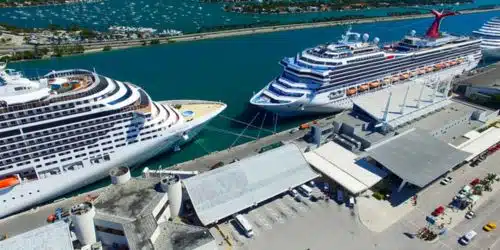Embarkation ports can be found in numerous coastal cities and regions worldwide, catering to various cruise routes and destinations. Some of the most popular embarkation ports are located in major cities and tourist hubs, making them easily accessible for travelers from different regions. To ensure a smooth embarkation process, travelers should arrive at the port with ample time before the scheduled departure. It is advisable to review the cruise line’s guidelines and requirements beforehand to avoid any delays or complications during check-in.
What is an Embarkation Port?
An embarkation port refers to the location from which passengers begin their journey on a cruise ship or other maritime vessel. It is the port where passengers board the ship and start their voyage. The choice of embarkation port can vary depending on the cruise itinerary and the cruise line’s offerings.
Features of Embarkation Ports
#1. Check-in and Boarding
When passengers arrive at the embarkation port, they go through a check-in process similar to that of an airport. They present their travel documents, such as passports or identification cards, and receive their cruise ship boarding pass. Luggage is taken by porters to be delivered to the stateroom later on the ship.
#2. Facilities
Major embarkation ports are equipped with various facilities to accommodate the needs of cruise passengers. These may include check-in counters, waiting areas, customs and immigration facilities, duty-free shops, restaurants, and transportation options to and from the port.
#3. Local Attractions
Embarkation ports are often located in or near popular tourist destinations. Allowing passengers to explore the local attractions before or after their cruise. Passengers may choose to arrive a day or two early to explore the port city and its surroundings.
#4. Transportation
Many embarkation ports have well-established transportation options, such as airports, train stations, and bus terminals nearby. This makes it convenient for passengers to reach the port from different locations.
#5. Cruise Itineraries
The choice of embarkation port can influence the cruise itinerary options available. Some cruises may start and end at the same port. Others may be one-way, ending at a different port. Passengers can choose itineraries that suit their preferences, taking into account the duration of the cruise and the destinations visited.
#6. Seasonal Variations
Some embarkation ports may have seasonal cruise schedules, offering specific routes during certain times of the year.
#7. Customs and Immigration
Depending on the embarkation port’s country and the destinations visited during the cruise, passengers will go through customs and immigration procedures. These formalities may vary, so passengers need to be aware of the requirements.
Types of Embarkation Ports
Here are some types of embarkation ports:
#1. Major Coastal Cities
These are large, well-developed cities located on the coast and serve as significant embarkation ports due to their accessibility and infrastructure. Examples include Miami (USA), Barcelona (Spain), and Sydney (Australia).
#2. Tourist Hubs
Some embarkation ports are located in popular tourist destinations, making them attractive starting points for cruises. Venice (Italy) and Honolulu (Hawaii, USA) are examples of embarkation ports in tourist hubs.
#3. Island Nations
Countries consisting of multiple islands often have embarkation ports from which passengers can start their cruise journeys. For instance, the Bahamas and Greece have various embarkation ports offering diverse cruise itineraries.
#4. Seasonal Ports
Some embarkation ports are seasonal and offer cruises only during specific times of the year. Ports in Alaska, which primarily operate during the summer months, are an example of seasonal embarkation ports.
#5. Regional Ports
These are smaller ports situated in regions that might not have the same level of tourist infrastructure as major coastal cities. They still offer cruise embarkation services. Examples include smaller ports in the Caribbean or the Mediterranean.
#6. Home ports
A homeport is a type of embarkation port where a cruise ship is based for a significant portion of the year. The ship departs and returns to the same homeport, offering various itineraries throughout the year. Fort Lauderdale (USA) and Southampton (UK) are examples of homeports.
#7. Long-Distance Departures
Some embarkation ports are used for cruises that cover extensive distances or transoceanic journeys. For example, ports in California may be used for cruises to Hawaii or the South Pacific.
#8. River Cruise Ports
While most embarkation ports are for ocean cruises, there are also embarkation points for river cruises. These ports are usually located along rivers in various countries and offer unique inland cruise experiences.
Tips On How To Choose The Best Embarkation Port
Here are some tips to help you choose the best embarkation port for your cruise:
#1. Itinerary
Choose an embarkation port that offers cruise itineraries aligned with your desired destinations and interests. Consider the places you want to visit during your cruise and check which embarkation ports cater to those locations.
#2. Accessibility
Opt for an embarkation port that is easily accessible from your location. If you can find a port that doesn’t require long-distance travel or additional flights. It can save you time and make your journey more convenient.
#3. Cruise Line Offerings
Different cruise lines have varying homeports and embarkation ports. Research the cruise lines that operate from specific embarkation ports and find the one that best matches your preferences and budget.
#4. Seasonal Considerations
Some embarkation ports and cruise itineraries are seasonal. Consider the time of year you plan to cruise and choose a port with itineraries available during that season.
#5. Pre- or Post-Cruise Exploration
If you want to spend some time exploring the embarkation city before or after your cruise. Select a port that offers interesting attractions, cultural experiences, and activities you enjoy.
#6. Cruise Length
Depending on the length of the cruise you prefer, certain embarkation ports may be better suited for shorter or longer voyages.
#7. Cost
Check for potential cost savings, as cruise fares can vary based on the embarkation port. Consider additional expenses such as flights, accommodations, and transportation to the port.
#8. Local Regulations and Requirements
Be aware of any specific travel requirements or COVID-19 restrictions related to the embarkation port and the destinations you’ll be visiting during your cruise.
Dos on an Embarkation Port
#1. Arrive Early
Plan to arrive at the embarkation port early to avoid potential delays and ensure a smoother check-in process.
#2. Check Cruise Line Guidelines
Familiarize yourself with the cruise line’s specific embarkation guidelines and requirements beforehand. This includes required documents, health protocols, and luggage policies.
#3. Keep Important Documents Handy
Have your travel documents, identification, boarding pass, and any required health-related paperwork readily accessible for check-in procedures.
#4. Pack Essential Items in Carry-On Luggage
Pack important items like medications, travel documents, a change of clothes, and other essentials in your carry-on luggage. Checked bags might not be available immediately after boarding.
#5. Be Polite and Patient
Be courteous to the embarkation staff and fellow passengers, as the process can be busy and may involve queues.
#6. Follow Health Protocols
Adhere to any health and safety measures in place, such as mask-wearing and social distancing, to ensure a safe embarkation process.
Don’ts on an Embarkation Port
#1. Don’t Arrive Late
Avoid arriving late to the embarkation port, as it could risk missing the cruise departure.
#2. Don’t Forget Important Documents
Ensure you have all necessary travel documents and identification. Forgetting vital paperwork can cause significant delays and complications.
#3. Don’t Overpack
Avoid overpacking, as it might result in additional luggage fees or difficulties transporting your belongings.
#4. Don’t Carry Prohibited Items
Be aware of the cruise line’s prohibited items list and avoid bringing any restricted items to the embarkation port.
#5. Don’t Ignore Safety Announcements
Pay attention to safety instructions and emergency announcements during the embarkation process and throughout the cruise.
#6. Don’t Cause Unnecessary Delays
Follow the instructions of the embarkation staff and complete check-in procedures promptly to avoid causing delays for yourself and others.
#7. Don’t Overindulge Before Boarding
Be mindful not to overindulge in alcohol or food that could lead to discomfort during the cruise.
What Is An Embarkation Location?
An embarkation location is a specific place or port where passengers begin their journey on a cruise ship or other water-based transportation. It serves as the starting point for travelers who are about to embark on a cruise vacation or sea voyage. The embarkation location is the actual physical site where passengers board the ship or vessel before the journey begins.
At the embarkation location, passengers go through various procedures, such as check-in, security screening, and customs clearance. They are required to present their identification, travel documents, and tickets during this process. Once onboard, passengers can access the ship’s amenities and activities, starting their journey to exciting destinations.
What Is Needed For Embarkation?
The requirements for embarkation can vary depending on the mode of transportation and the destination. For air travel, a valid passport and any necessary visas are required. Passengers may also need to complete an embarkation card with their personal and travel information. For cruise travel, passengers will need to provide identification and travel documents. Proof of vaccination or negative COVID-19 test results and any required visas or travel authorization forms. Passengers may also need to complete a health questionnaire and undergo a health screening before embarking on certain modes of transportation. It is always recommended to check with the transportation provider and destination authorities for specific embarkation requirements.
What Should Happen During Embarkation?
During embarkation, the process can vary depending on the mode of transportation and the destination, but it involves the following steps:
- Checking in and presenting necessary travel documents, such as a passport or visa
- Security screening
- Handing over luggage to a porter
- Completing any required health questionnaires or screenings
- Boarding the transportation
How Long Is The Embarkation?
The duration of embarkation can vary depending on the mode of transportation, the destination, and the specific circumstances at the time of travel. Factors such as the size of the travel party, the amount of luggage, the time of day, and the level of security screening required. The efficiency of the transportation provider can impact the duration of embarkation. While some people may be able to complete the embarkation process quickly and easily, others may experience delays or other challenges that lengthen the process. It is always recommended to allow plenty of time for embarkation and to arrive early to avoid potential delays.
What If I Miss My Embarkation Time?
If you miss your embarkation time, it is important to contact your transportation provider or cruise line as soon as possible to let them know. The specific procedures for handling missed embarkation can vary depending on the provider and situation. You may be able to board the transportation later in the journey, depending on availability and other factors. However, there may be additional costs or fees associated with missed embarkation. It is always best to contact the provider and determine your options as soon as possible. It is also recommended to purchase travel insurance, which can provide coverage for missed departures due to covered reasons.
What Is The Embarkation Time?
The embarkation time refers to the time that passengers are required to arrive at the cruise terminal or port to begin boarding the ship or vessel for their vacation. The specific embarkation time can vary depending on the transportation provider and the specific circumstances of the journey. Some cruise lines assign staggered arrival times to reduce wait times and ensure a smooth embarkation process for all passengers. Passengers need to check with the transportation provider for their specific embarkation time. Arrive promptly to reduce the wait time in line.
What Is The Procedure For Embarkation And Disembark?
The procedure for embarkation and disembarkation can vary depending on the mode of transportation and the specific circumstances of the journey. Generally, for air travel, passengers are required to present a valid passport and any necessary visas. Complete an embarkation card, and undergo security screening before boarding the plane. For cruise travel, passengers may need to provide identification and travel documents. Proof of vaccination or negative COVID-19 test results, and any required visas or travel authorization forms.
As well as complete any required health questionnaires or screenings. The process of boarding and disembarking a ship or airplane involves the use of platforms or steps. This is to provide even levels between the boat and the point of embarkation/disembarkation. It is recommended that passengers arrive promptly for their embarkation. And also to allow plenty of time for disembarkation at the end of the journey to avoid unexpected delays.
What To Do After Boarding The Ship?
After boarding a ship, there are several things you can do. The exact procedures can vary depending on the type of ship.
Here are some general suggestions:
- Check-In and drop off luggage to your room
- Attend the muster drill or safety briefing
- Explore and get familiar with the ship
- Have a meal or snack
- Make reservations for specialty restaurants and activities
- Attend shows or activities scheduled for the day
- Head to the pool, spa, or gym for a workout or relaxation
- Check out any onboard shopping options or casinos, if applicable.
Conclusion
An embarkation port refers to the location from which passengers start their journey on a cruise ship or other types of water-based transportation. It serves as the departure point for travelers embarking on a cruise vacation or a sea voyage. These ports are strategically chosen based on their accessibility, facilities, and proximity to popular tourist destinations.
An embarkation port marks the starting point of a cruise journey and is critical in ensuring a seamless and enjoyable experience as travelers set sail to exciting destinations. The process of embarking at the port involves various procedures such as check-in, security screening, and customs clearance. Passengers are required to present their identification, travel documents, and tickets during this process. Once onboard, travelers can access a range of amenities and activities, making the embarkation port an essential part of the overall cruise experience.
Related Articles
- 21 TOP BUDGET TRAVEL TIPS
- BEST DESTINATIONS FOR VACATION IN AFRICA
- POST-VACATION DEPRESSION: How To Cope With It
- HOW TO TRAVEL WITH A DOG: Detailed Guide
- BEST TRAVEL FIRST AID KIT OF 2023






